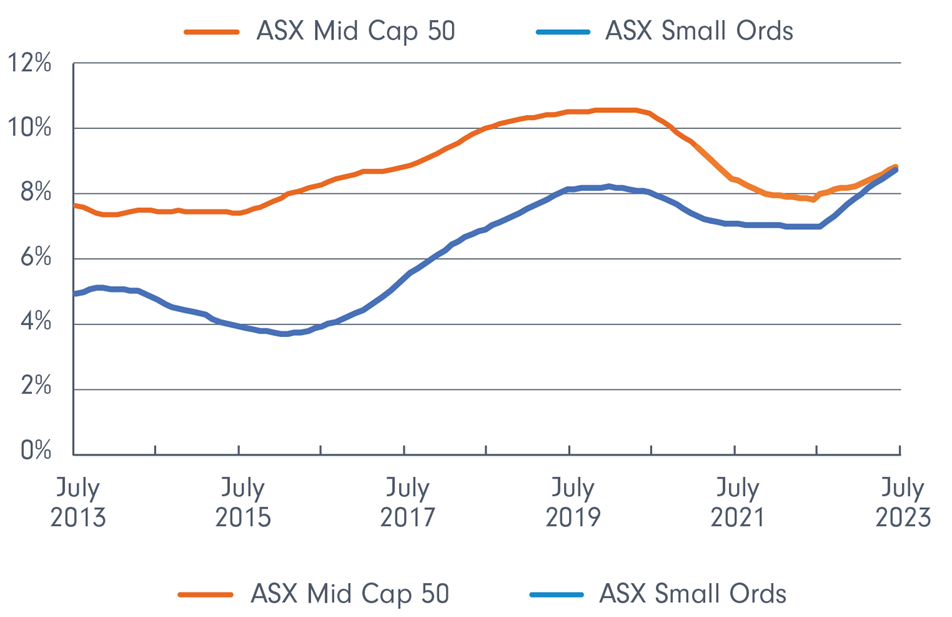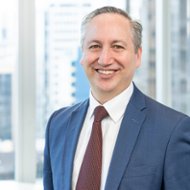Through the market ups and downs, the Fidelity Future Leaders Fund has returned 10.62% return pa* (net of fees) for investors since its inception in July 2013. To celebrate the 10-year anniversary of the Fund, we speak with portfolio manager, James Abela, to find out what it takes to find the future leaders of tomorrow, today.
What made you go against the grain to launch a mid-small cap fund when peers were focussing solely on smaller companies?
As you say, prior to the Fund’s inception, there was a lot of chatter in the market about launching a small-cap fund because ‘that’s what everyone does’. But what I found in my research was that the return on equity (ROE) in the mid-cap space was higher. So, I formulated a list of around ten or so points and took it to the Global Head of Investments at the time to pitch my case. I firmly believed this Fund needed to be broader than a pure small-cap fund.
I’m happy to see a that a decade since the Fund’s inception, we’re still seeing this trend - a marked difference in total return and in ROE between these markets; that is, a higher return of equity for investments in the mid cap index vs small caps.
Comparison of rolling 3 year total return over the last 10 years

Comparison of rolling 3 year ROE over the last 10 years

Source: FactSet, data date range: 31 July 2013 - 31 July 2023
How do you identify the true future leaders of tomorrow, today?
At its core, we aim to identify and select stocks with future growth potential, that is, small-cap companies that can graduate into mid-cap companies, and mid-cap companies that can graduate into large-cap companies.
Our stock selection process relies on a rigorous, multi-discipline approach where we identify stocks with characteristics of VSC: Viability, Sustainability, and Credibility .
- Viability: this is data driven and identifies things like the ROE volatility and pricing power
- Sustainability: this focuses on the consistency and reliability of these returns including a companies’ ESG performance and customer entrenchment
- Credibility: at this stage, we rely on our conviction and experience to assess the management of a company and its presentation in the market
In our view, over 5-10 years, stocks with high VSC scores are likely to exhibit a high probability of becoming the future leaders of tomorrow.
Using our VSC model, we pleasingly saw companies we held like Qantas, James Hardie, Sydney Airport, and Pilbara Mining, graduate into the top 50s (by market capitalisation).
Current holdings with the same potential, that have been large contributors to performance to date, include WiseTech Global, Altium, ResMed, Fisher and Paykel, and Pro Medicus.
What are the key stock categories that have shaped the Fund as it stands today?
I believe there are three categories of stocks that have shaped long-term growth in the Fund.
- High quality stocks i.e., quality compounders.
Quality compounders are those stocks that are purchased when valuations are low and continue to grow in value thanks to a variety of reasons including great management teams or a lack of strong competitors in the market. In general, if we can find these, we simply hold onto them with patience. The majority of the Fund’s alpha has been thanks to compounders and include:
- Technology software - Altium, Wisetech, Aconex, Xero
- Healthcare technology - Resmed, ProMedicus, Fisher & Paykel
- Fintech - Netwealth, Pinnacle Investment Management
- Consumer technology - Aristocrat, Corporate Travel Management
2. Momentum, loss-making, concept, and thematic stocks
The characteristics of thematic stocks are varied.
Earnings driven stocks are backed by their strong returns and combined with their thematic, generally make for a positive investment. If we weren’t keeping abreast of themes that may drive huge earnings, we would potentially miss a whole lot of opportunity.
Our holdings in A2 Milk, Blackmores, and Bellamy paid off during 2017-2019, when demand for infant formula and vitamins in Asia was a key thematic. These stocks experienced rapid sales growth, high margins, and expanding valuation multiples.
Concept based stocks tend to be very flippant; earnings are often only accumulated in a short time, and generally there is strong sentiment, story or innovation concept supporting the stock rather than earnings.
Another success followed the boom in electric vehicles, which is backed by lithium. We have seen strong returns from our investments in Pilbara Minerals, IGO, and Galaxy Resources after recognising Australia is one of only few countries to produce and export the resource.
Businesses that are driven by story but are loss making in sentiment can be hard to invest or trade in. A missed opportunity for the Fund was in Afterpay. During the Covid pandemic, the stock fell to $10 (around mid-2020) then subsequently rose to $150 (early 2021) when the ‘free money’, lockdowns, and government assistance occurred. But as the business raised money many times, and valuations were running on the thematic rather than reality, it was difficult to have strong conviction and invest.
As fellow portfolio manager, Anthony Bolton, once said, “sentiment can be just as important, if not more powerful than fundamentals.” I try to keep this in mind when thinking about momentum, loss-making, concept, and thematic stocks.
Looking back on the past 10 years, what are you most proud of?
Above all else, I am proud of the success we have been able to achieve for all our clients. The conviction in our portfolio construction has allowed us to be excited about the future, to continue to seek the future leaders of tomorrow.
*as at 31 July 2023

